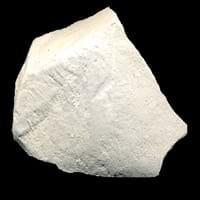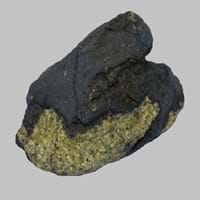Definition
Chalk is a soft, white, powdery limestone consisting mainly of fossil shells of foraminifers
Basanite is a black basaltic rock which mainly contains plagioclase, augite, olivine and nepheline and is formerly used as a touchstone
Discoverer
Unknown
Unknown
Etymology
From old English cealc chalk, lime, plaster; pebble, from Greek khalix small pebble, in English transferred to the opaque, white, soft limestone
From Latin basanites + -ite
Class
Sedimentary Rocks
Igneous Rocks
Sub-Class
Durable Rock, Soft Rock
Durable Rock, Hard Rock
Group
Not Applicable
Not Applicable
Other Categories
Fine Grained Rock, Opaque Rock
Fine Grained Rock, Opaque Rock
Texture
Clastic or Non-Clastic
Aphanitic to Porphyritic
Color
Grey, White, Yellow
Black, Brown, Green, Grey, Red, White
Durability
Durable
Durable
Appearance
Soft
Glassy or Pearly
Interior Uses
Decorative Aggregates, Homes, Interior Decoration
Decorative Aggregates, Homes
Exterior Uses
As Building Stone, As Facing Stone, Paving Stone, Garden Decoration
As Building Stone, Garden Decoration, Office Buildings
Other Architectural Uses
Powder
Whetstones
Construction Industry
As Dimension Stone, Cement Manufacture, Construction Aggregate, for Road Aggregate, Making natural cement, raw material for manufacture of quicklime and slaked lime, Source of calcium
Arrowheads, Construction Aggregate, Cutting Tool, Spear Points
Medical Industry
Not Yet Used
Not Yet Used
Antiquity Uses
Artifacts, Monuments, Sculpture, Small Figurines
Artifacts, Monuments
Commercial Uses
Alumina Refineries, Creating Artwork, Drawing on blackboards, Gymnasts, athletes and mountain climbers use for grip, In aquifers, Paper Industry, Production of Lime, Raw material for manufacture of quicklime, slaked lime, Soil Conditioner, Whiting, Whiting material in toothpaste, paint and paper
As a touchstone, Creating Artwork, Gemstone, In fire-starting tools, Manufacture of tools, Metallurgical Flux, Jewelry, To ignite fire, Used in flintlock firearms
Types
Not Available
Nepheline-Basanite, Analcite-Basanite and Leucite-Basanite
Features
Clasts are smooth to touch, Is one of the oldest rock, Smooth to touch, Very fine grained rock
Clasts are smooth to touch, Easily splits into thin plates, Has High structural resistance against erosion and climate, Used as a touchstone
Archaeological Significance
Famous Monuments
Data Not Available
Data Not Available
Sculpture
Used
Not Yet Used
Famous Sculptures
Data Not Available
Not Applicable
Pictographs
Used
Not Used
Petroglyphs
Used
Not Used
Figurines
Used
Not Yet Used
Formation
Chalk is formed from lime mud, which accumulates on the sea floor which is then transformed into rock by geological processes.
Basanite is a fine-grained, hard rock that forms when bits of lava shoot out of volcanoes.
Mineral Content
Calcite, Clay, Clay Minerals, Quartz, Sand
Augite, Feldspar, Ilmenite, Olivine, Plagioclase
Compound Content
Ca, NaCl, CaO
Potassium Oxide, Sodium Oxide, Silicon Dioxide
Types of Metamorphism
Not Applicable
Burial Metamorphism, Cataclastic Metamorphism, Contact Metamorphism, Regional Metamorphism
Types of Weathering
Biological Weathering, Chemical Weathering
Chemical Weathering, Mechanical Weathering
Types of Erosion
Chemical Erosion, Coastal Erosion, Water Erosion
Chemical Erosion, Coastal Erosion, Glacier Erosion, Sea Erosion, Water Erosion, Wind Erosion
Grain Size
Very fine-grained
Fine Grained
Fracture
Not Available
Uneven, Splintery or Conchoidal
Porosity
Highly Porous
Highly Porous
Luster
Dull
Waxy and Dull
Cleavage
Non-Existent
Non-Existent
Specific Gravity
2.3-2.4
2.5-2.8
Transparency
Opaque
Translucent to Opaque
Density
2.49-2.50 g/cm3
2.7 g/cm3
Resistance
Heat Resistant
Heat Resistant, Impact Resistant, Pressure Resistant, Wear Resistant
Deposits in Eastern Continents
Asia
Brunei, India, Indonesia, Malaysia, Singapore, Thailand, Vietnam
Not Yet Found
Africa
Cameroon, Chad, Ghana, Kenya, Malawi, Sudan, Tanzania, Togo, Zambia, Zimbabwe
Uganda
Europe
England, France, Germany, Spain, United Kingdom
Germany, Hungary, Italy, Spain
Others
Not Yet Found
Greenland, Mid-Atlantic Ridge
Deposits in Western Continents
North America
Canada, USA
USA
South America
Colombia
Bolivia, Brazil
Deposits in Oceania Continent
Australia
Adelaide, New Zealand, Queensland, Tonga, Victoria, Yorke Peninsula
New South Wales, New Zealand, Queensland, South Australia, Western Australia
Chalk vs Basanite Characteristics
Though some rocks look identical, they have certain characteristics which distinguish them from others. Characteristics of rocks include texture, appearance, color, fracture, streak, hardness etc. Chalk vs Basanite characteristics assist us to distinguish and recognize rocks. Also you can check about Properties of Chalk and Properties of Basanite . Learn more about Chalk vs Basanite in the next section. The interior uses of Chalk include Decorative aggregates, Homes and Interior decoration whereas the interior uses of Basanite include Decorative aggregates and Homes. Due to some exceptional properties of Chalk and Basanite , they have various applications in construction industry. The uses of Chalk in construction industry include As dimension stone, Cement manufacture, Construction aggregate, For road aggregate, Making natural cement, Raw material for manufacture of quicklime and slaked lime, Source of calcium and that of Basanite include Arrowheads, Construction aggregate, Cutting tool, Spear points.
More about Chalk and Basanite
Here you can know more about Chalk and Basanite . The life cycle of a rock consists of formation of rock, composition of rock and transformation of rock. The composition of Chalk and Basanite consists of mineral content and compound content. The mineral content of Chalk includes Calcite, Clay, Clay Minerals, Quartz, Sand and mineral content of Basanite includes Augite, Feldspar, Ilmenite, Olivine, Plagioclase. You can also check out the list of all Sedimentary Rocks. When we have to compare Chalk vs Basanite , the texture, color and appearance plays an important role in determining the type of rock. Chalk is available in grey, white, yellow colors whereas, Basanite is available in black, brown, green, grey, red, white colors. Appearance of Chalk is Soft and that of Basanite is Glassy or Pearly. Properties of rock is another aspect for Chalk vs Basanite . The hardness of Chalk is 1 and that of Basanite is 7. The types of Chalk are Not Available whereas types of Basanite are Nepheline-Basanite, Analcite-Basanite and Leucite-Basanite. Streak of rock is the color of powder produced when it is dragged across an unweathered surface. The streak of Chalk and Basanite is white. The specific heat capacity of Chalk is 0.90 kJ/Kg K and that of Basanite is 0.74 kJ/Kg K. Depending on the properties like hardness, toughness, specific heat capacity, porosity etc., rocks are resistant to heat, wear, impact, etc.Chalk is heat resistant whereas Basanite is heat resistant, impact resistant, pressure resistant, wear resistant.





